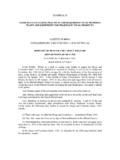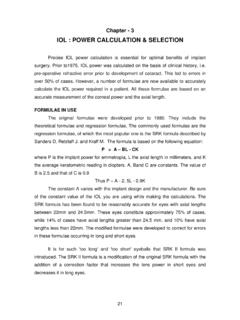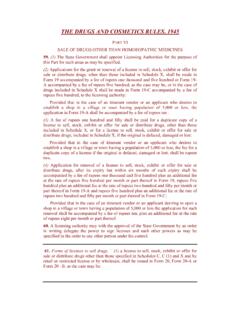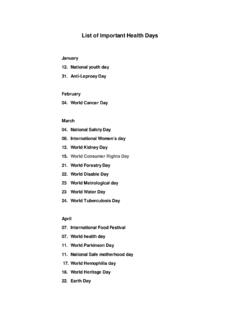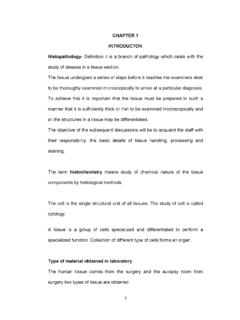Transcription of CHAPTER 1 INTRODUCTON Histopathology
1 1 CHAPTER 1 INTRODUCTON Histopathology - Definition it is a branch of pathology which deals with the study of disease in a tissue section. The tissue undergoes a series of steps before it reaches the examiners desk to be thoroughly examined microscopically to arrive at a particular diagnosis. To achieve this it is important that the tissue must be prepared in such a manner that it is sufficiently thick or thin to be examined microscopically and all the structures in a tissue may be differentiated. The objective of the subsequent discussions will be to acquaint the staff with their responsibility; the basic details of tissue handling, processing and staining. The term histochemistry means study of chemical nature of the tissue components by histological methods. The cell is the single structural unit of all tissues. The study of cell is called cytology. A tissue is a group of cells specialized and differentiated to perform a specialized function.
2 Collection of different type of cells forms an organ. Type of material obtained in laboratory The human tissue comes from the surgery and the autopsy room from surgery two types of tissue are obtained. 21. As biopsy- A small piece of lesions or tumor which in sent for diagnosis before final removal of the lesion or the tumor (Incisional biopsy). 2. If the whole of the tumor or lesion is sent for examination and diagnosis by the pathologist, it is called excisional biopsy. 3. Tissues from the autopsy are sent for the study of disease and its course, for the advancement of medicine. Types of Histological preparation The histological specimen can be prepared as 1. Whole mount 2. Sections 3. Smears. 1. Whole mounts- These are preparation entire animal eg. fungus, parasite. These preparations should be no more than mm in thickness. 2. Sections- The majority of the preparations in histology are sections.
3 The tissue is cut in about 3-5 mm thick pieces processed and 5 microns thick sections are cut on a microtome. These are then stained and permanently mounted. Microtomes are special instruments which have automatic mechanism for cutting very thin sections. To cut the sections on the microtome; the tissue must be made hard enough to not get crushed. There are 2 methods of hardening the tissues. One is by freezing them and the other is by embedding them in a hard material such at paraffin wax or gelatin. 33. Smears- Smears are made from blood, bone marrow or any fluid such as pleural or ascitic fluid. These are immediately fixed in alcohol to presence the cellular structures are then stained. Smears are also made by crushing soft tissue between two slides or an impression smear in made by pressing a clean slide in contact with the moist surface of a tissue. By doing this, the cells are imprinted on the slide and these may be stained for cytological examination.
4 4 Responsibility of a technician The technician is responsible for 1. Specimen preservation. 2. Specimen labeling, logging and identification. 3. Preparation of the specimen to facilitate their gross and microscopy. 4. Record keeping. To obtain these aims the following point need consideration. 1. As soon as the specimen is received in the laboratory, check if the specimen is properly labeled with the name, age, Hospital Registration No. and the nature of tissue to be examined and the requisition form is also duly filled. 2. Also check if the specimen is in proper fixative. Fixative should be fifteen to twenty times the volume of the specimen add fixative if not present in sufficient amount. 3. Check if the financial matters have been taken care off. 4. Make the entries in biopsy register and give the specimen a pathology number called the accession number. Note this number carefully on the requisition form as well as the container.
5 This number will accompany the specimen every where. 5. If the specimen is large inform the pathologist who will make cut in the specimen so that proper fixation is done. Container should be appropriate to hold the specimen without distorting it. 56. Blocks of tissues taken for processing should be left in 10% formalin at 60 C till processing. These would be fixed in 2 hours. 7. Slides should be released for recording after consultation with the pathologist. 8. Specimens should be kept in their marked container and discarded after checking with pathologist. 9. Block must be stored at their proper number the same day. Note the blocks have to be kept preserved for life long. Slides should be stored in their proper number after 3 days. It gives time for the slides to be properly dried. 6 CHAPTER -2 FIXATION Definition It is a complex series of chemical events which brings about changes in the various chemical constituents of cell like hardening, however the cell morphology and structural detail is preserved.
6 Unless a tissue is fixed soon after the removal from the body it will undergo degenerative changes due to autolysis and putrefaction so that the morphology of the individual cell will be lost. Mode of teaching - Overhead projector and practical demonstration. Principle of fixation- The fixative brings about crosslinking of proteins which produces denaturation or coagulation of proteins so that the semifluid state is converted into semisolid state; so that it maintains everything in vivo in relation to each other. Thus semisolid state facilitate easy manipulation of tissue. Aims and Effects of fixation If a fresh tissue in kept as such at room, temperature it will become liquefied with a foul odour mainly due to action of bacteria putrefaction and autolysis so the first and fore most aim of fixation is 1. To preserve the tissue in as lf like manner as possible. 2. To prevent postmortem changes like autolysis and putrefaction.
7 Autolysis is the lysis or dissolution of cells by enzymatic action probably as a result of rupture of lysosomes. Putrefaction The breakdown of tissue by bacterial action often with 7formation of gas. 3. Preservation of chemical compounds and microanatomic constituents so that further histochemistry is possible. 4. Hardening : the hardening effect of fixatives allows easy manipulation of soft tissue like brain, intestines etc. 5. Solidification: Converts the normal semifluid consistency of cells (gel) to an irreversible semisolid consistency (solid). 6. Optical differentiation - it alters to varying degrees the refractive indices of the various components of cells and tissues so that unstained components are more easily visualized than when unfixed. 7. Effects of staining - certain fixatives like formaldehyde intensifies the staining character of tissue especially with haematoxylin. Properties of fixatives 1. Coagulation and precipitation as described above.
8 2. Penetration Fixation is done by immersing the tissue in fluid containing the fixative. Faster a fixative can penetrate the tissue better it is penetration power depends upon the molecular weight formalin fixes faster than osimic acid. 3. Solubility of fixatives - All fixatives should be soluble in a suitable solvent, preferably in water so that adequate concentrations can be prepared. 4. Concentration - It is important that the concentration of fixative is isotonic or hypotonic 85. Reaction - Most fixatives are acidic. It may help in fixation but can affect staining so has to be neutralized formalin is neutralized by adding of calcium carbonate. Amount of fixative The fixative should be atleast 15-20 times the bulk of tissue. For museum specimens the volume of fixative is > 50 times. Note : If the specimen is large then see that the sections are made to make slices which have a thickness of cm so that fixative can penetrate the tissue easily Reagents employed as fixatives (simple fixatives) I.
9 Formaldehyde - Formaldehyde is a gas but is soluble in water to the extent of 37-40% w/v. This solution of formaldehyde in water is called formalin or full strength formalin. Formalin is one of the commonly used fixative in all laboratories since it is cheap penetrates rapidly and does not over harden the tissues. It preserves the proteins by forming crosslinkage with them and the tissue component. It denatures the proteins. Glycogen is partially preserved hence formalin is not a fixative choice for carbohydrates. Some enzymes can be demonstrated in formalin fixed tissues. It neither preserves nor destroys fat. Complex lipids are fixed but has 9no effect on neutral fat. After formalin fixation fat may be demonstrated in frozen section. Pure formalin is not a satisfactory fixative as it overhardens the tissue. A 10% dilution in water (tap or distilled) is satisfactory. Since it oxidizes to formic acid if kept standing for long period so it should be neutralized by phosphates or calcium carbonate otherwise it tends to form artifact; a brown pigment in tissues.
10 To remove this pigment picric alcohol or saturated alcoholic sodium hydroxide may be used. Concentrated formalin should never be neutralized as there is a great danger of explosion. The commercial formalin becomes cloudy on standing especially when stored in a cool place due to formation of precipitate of paraformaldehyde which can be filtered. Formalin on prolonged exposure can cause either dermatitis its vapour may damage the nasal mucosa and cause sinusitis. Time required for fixation. At room temperature - 12 hours For small biopsies - 4-6 hours At 65 C fixation occurs in - 2 hours II. Alcohol (Ethyl Alcohol) Absolute alcohol alone has very little place in routine fixation for Histopathology . It acts as a reducing agents, become oxidized to acetaldehyde and then to acetic acid. 10 It is slow to penetrate, hardens and shrinks the tissue. Alcohol penetrates rapidly in presence of other fixative hence in combination Carnoy's fixative is used to increase the speed of tissue processing.
